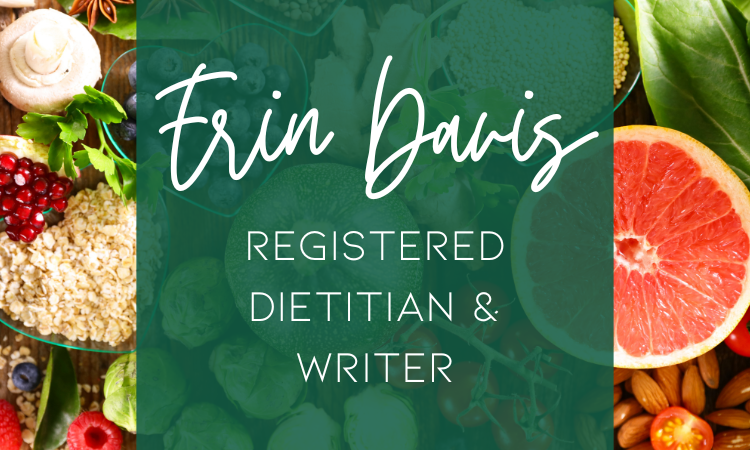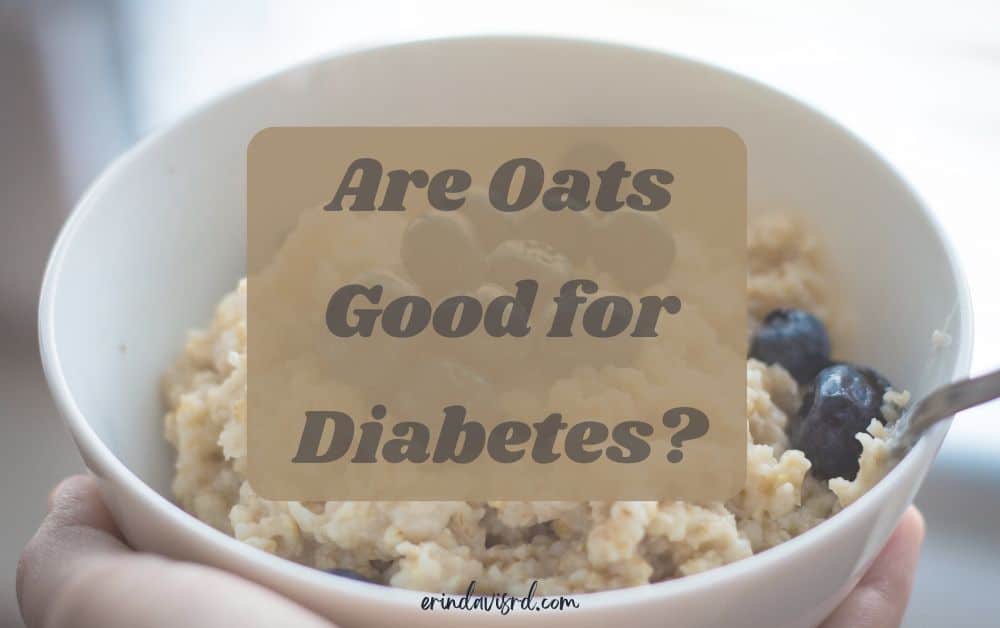If you think you need to cut carbs to manage your diabetes, I’m here to tell you that you’ll be missing out! Oats are a grain (carb) that has some major benefits. So are oats good for diabetes? In this post, I’ll be sharing all of the benefits of oats, including those for people with diabetes.
As a diabetes educator, I often get questioned about what foods are best to eat to manage diabetes. Between social media, health care providers, and “friendly” advice from others, the messaging around food can be confusing.
“Eat multiple small meals.” “Prioritize breakfast.” “Fast and skip breakfast.” “Don’t eat carbs.” “Eat whole grains.” “Fruits and veggies are good.” “There’s too much sugar in fruit and certain vegetables.”
Sound familiar? It’s enough to make your head spin. The great thing about intuitive eating for diabetes is that you don’t have to stick with rigid food rules that are often associated with diabetes.
That means you can eat carbs. Of course, there are certain carbs more nutrient-dense than others, and one of those is oats.
Oats are good for diabetes because of their numerous benefits—high in fiber, slowly digested, rich in vitamins, filling, and satisfying. Plus they’re super versatile, so you can eat them any way you like.
So whether you like overnight oats, a bowl of oatmeal, or oat-based energy balls, you’ll reap the benefits of oats.
Please note: As an Amazon Associate, I earn from qualifying purchases.
What are Oats?

Oats are a cereal grain prized for its seed. They are an excellent food for everyone, including people with diabetes. Oats are nutrient-dense, and shelf-stable—making it a great staple food.
First of all, oats are packed with fiber, which means they’ll keep you full and satisfied. Next, they have a balance of high-quality protein. Yep, it’s a grain that has protein (~5 grams in a 1-cup serving), so it makes a perfectly balanced meal.
Not to mention all of the vitamins, minerals, and antioxidants oats contain, as well as protein, fiber, healthy fats, iron, zinc, magnesium, beta-glucan, and other plant compounds.
While oats are a source of carbohydrates, no need to worry. (Please note, you do NOT have to give up carbs if you have diabetes!)
Carbs are our primary source of fuel for our everyday activities. Carbs are not bad. But it’s important to know how your body responds to the different kinds.
Oats are a complex carb that takes time to digest and have some special qualities that actually make it beneficial for your blood sugars. Here’s a rundown of the benefits.
Benefits of Oats for Diabetes
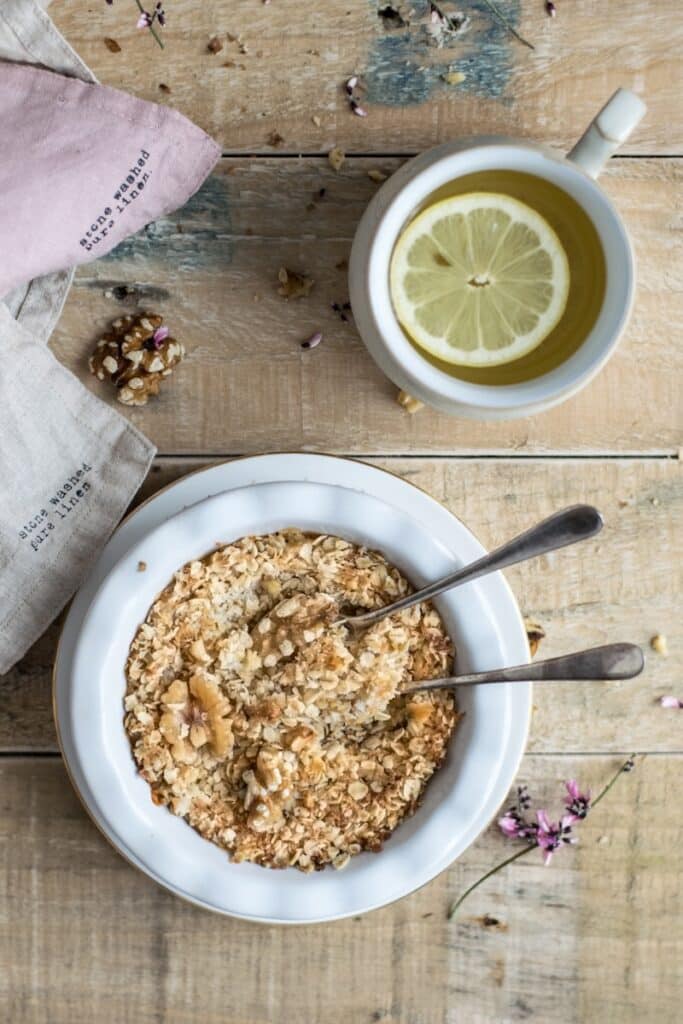
The number of benefits of oats is impressive, for sure. Some reasons to add oats to your diet include:
1. Reduction of average blood sugar
While it may seem like oats, being a carb, would raise blood sugar, it actually has the opposite effect. Studies have shown that eating oats can significantly lower post-meal and fasting blood sugars in those with diabetes.
It’s suspected that oats work in the following ways to lower blood sugar:
Delayed gastric (stomach) emptying
- The soluble fiber beta-glucan forms a gel-like substance in the stomach and small intestine This slows down the rate at which food leaves the stomach.
- This results in a slower and steadier absorption of carbohydrates, preventing blood sugar spikes.
Reduced glucose absorption
- The gel formed by beta-glucan also physically slows down the movement of glucose through the digestive tract, reducing its absorption into the bloodstream.
Promotion of a healthy gut microbiome
- Oats can act as a prebiotic, feeding beneficial gut bacteria that produce short-chain fatty acids (SCFAs).
- SCFAs, especially butyrate, are known to enhance insulin sensitivity and reduce systemic inflammation, which can contribute to better blood sugar control.
Improved insulin sensitivity
- Regular consumption of soluble fiber like beta-glucan has been linked to better insulin sensitivity, meaning the body can use insulin more effectively to lower blood sugar levels.
- Lower insulin resistance can help in long-term blood sugar control, especially in individuals with prediabetes or type 2 diabetes.
2. Lower insulin levels
Insulin levels in people with diabetes can be elevated because your body is trying to overcompensate for high blood sugars.
Lower insulin levels allow the body’s cells to become more responsive to insulin, reducing the risk of insulin resistance and improving blood sugar control.
Insulin is a storage hormone, so increased insulin levels may lead to weight gain or difficulty maintaining your weight. You may also feel hungrier when your insulin levels are high.
Furthermore, excess insulin and insulin resistance have been associated with other conditions like heart disease and Alzheimer’s disease.
Multiple research studies have shown the impact of eating oats on insulin levels. After regular oatmeal consumption, people with type 2 diabetes had lower levels of insulin.
Diets higher in whole oats and oat bran are associated with lower HbA1c (blood sugar average over a 2-3 month period) and fasting insulin in those with type 2 diabetes.
3. Reduced LDL cholesterol
Oats are known for lowering cholesterol. First, let’s talk a bit about the different types of cholesterol.
LDL cholesterol, or low-density lipoprotein cholesterol, is the “bad” cholesterol. Too much LDL can lead to harmful buildup in your arteries.
HDL cholesterol, or high-density lipoprotein cholesterol, is the “good” cholesterol. HDL cholesterol is like a street sweeper and aids in removing excess cholesterol.
People with diabetes are at a higher risk of cardiovascular disease and diet is one way to lower that risk.
The beta-glucan (soluble fiber) in oats can lower LDL cholesterol by promoting excretion. Basically, it helps your body get rid of cholesterol
Research suggests that eating 3 grams of soluble fiber per day from oats can help lower LDL cholesterol by about 5-10%. To achieve this, the typical daily recommended intake of oats is 1.5 to 2 cups of cooked oats.
If that’s more than you feel comfortable eating, that’s okay. Remember that even half of that will have some benefit—just maybe not quite as much of a lowering effect.
4. Improved satiety
Satiety, or feeling full, is the goal after eating.
When you feel satisfied, you are less likely to constantly snack or crave starchy foods. Many studies prove that oats help you better feel full.
Not only are oats high in dietary fiber, which provides bulk and slows digestion and promotes satiety, but beta glucan may impact hunger-regulating hormones.
Our appetites are a complex process. A number of factors tell you when to eat and when to stop. Part of the hunger and fullness regulation is done by hormones ghrelin, leptin, GLP-1, and PPY.
It turns out that beta-glucan can change the appetite hormones for the good. Basically, oats help your hunger fullness signals work properly. This can lead to lower calorie intake and better blood sugar levels.
5. Improved gut health
Another reason to eat oats when you have diabetes is for better gut health.
What does the gut have to do with diabetes? The gut is home to trillions of bacteria that form the gut microbiome, which influences key processes like glucose metabolism, inflammation, and insulin sensitivity.
When your gut is out of whack, you can experience increased blood sugars and even more serious conditions like chronic inflammation.
Your gut bacteria can also affect appetite hormones, which you want working in harmony so that you eat the appropriate amount of food for your body.
Additionally, a diverse gut microbiome promotes weight management and makes your body more sensitive to insulin, making it easier to manage blood sugars.
And let’s not forget about the gut’s role in the immune system. Gut bacteria regulate the gut barrier, prevent harmful pathogens from entering the bloodstream, and promote the production of anti-inflammatory compounds that enhance immune function.
The beta-glucan in oats has the potential to positively change your gut bacteria. So eating a bowl of oatmeal may improve your overall gut health.
Which Oats Are Good for Diabetes?
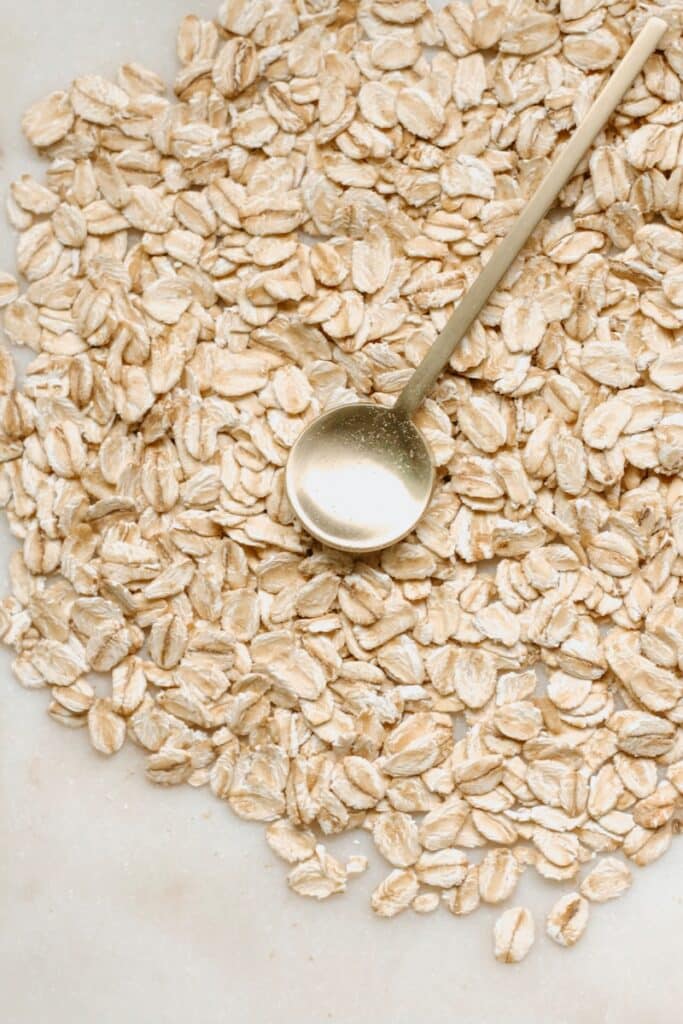
You may be wondering which oats are the best for someone with diabetes. You can feel free to choose whatever kind you like best, but some varieties are less processed and have more nutrients.
Oats that have little processing contain more of the plant. The following are the different types of oats in order of least processed to most processed.
- Oat groats: The least processed oat you can eat, groats have only the outer husk removed. Groats have a more dense and chewy texture and take a while to cook. Soaking overnight can speed up cooking time and make them easier to digest. One cup=26-28 grams carbs
- Steel-cut oats: Also known as Irish oats, steel-cut oats are cut into thirds by…you guessed it, steel blades. Steel-cut oats take about half of the time to cook when compared to groats, but also have a chewy texture. One cup=28 grams carbs
- Scottish oats: These oats are ground by stone, so they have a fine texture that results in a creamy oatmeal. One cup=27 grams carbs
- Rolled oats or old-fashioned oats: This is one of the most affordable ways to include oats in your diet. They are processed by steaming groats and flattening them with rollers. They cook up in around 5 minutes. One cup=24-28 grams carbs
- Quick oats: As the name implies, quick oats cook up faster (1-3 minutes) than the other types. Processors steam the groats longer, flatten them, then take the rolled oats and chop them up into small pieces. One cup=25-28 grams carbs
- Instant oats: Often sold in packets for convenience, instant oats are pre-cooked, so you need only add hot water for them to get mushy. One cup=27-28 grams carbs
Of course, it is ideal to choose the oats that have retained more nutrients and are less processed, but that requires time. Rolled oats can be a happy medium.
Diabetes-Friendly Toppings for Oats
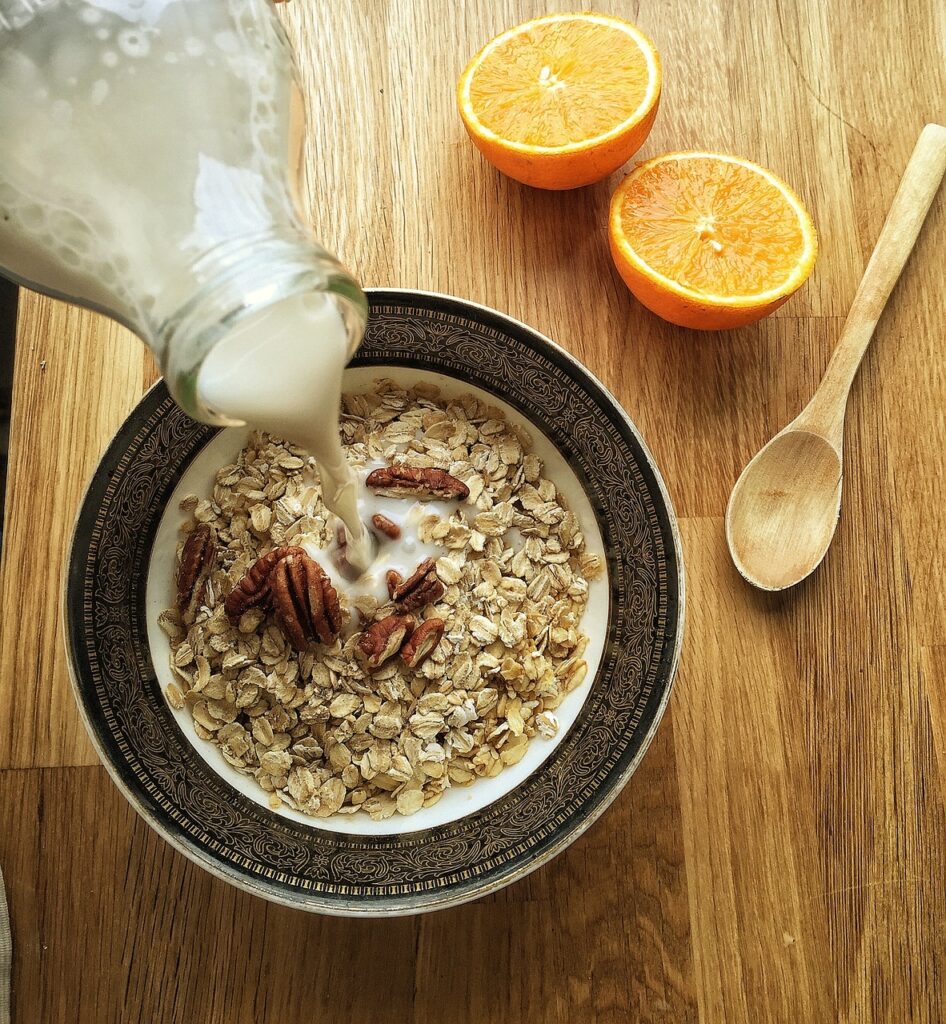
Sometimes it’s what we put in the oatmeal (like brown sugar) that can cause our blood sugars to spike.
Don’t get me wrong, brown sugar in oatmeal is delicious. But too much sugar+oats may lead to high blood sugars.
Here are some ideas to add some flavor to your oatmeal:
1. Nuts, seeds, and other fats
- A couple tablespoons of chopped almonds, walnuts, or pecans
- A tablespoon of chia seeds or hemp hearts
- A splash of almond or coconut milk
- A tablespoon of pumpkin seeds
- Coconut flakes (unsweetened)
- A small amount of nut butter (almond, peanut, or sunflower seed)
2. Fresh fruits
- A handful of berries (raspberries, blackberries, strawberries)
- A tablespoon or two of chopped dates
- A tablespoon of canned pumpkin (add vanilla or chai flavored protein powder for pumpkin pie flavor oatmeal)
3. Spices and flavorings
- Cinnamon, nutmeg, or cardamom
- Allspice
- Pumpkin pie spice
- Extracts like pure vanilla extract, peppermint (try with a teaspoon of cocoa powder or chocolate protein powder for peppermint mocha oats), or almond extract
4. Sweeteners
- Maple syrup is high in plant compounds that act as antioxidants
- Honey has other health benefits due to its anti-inflammatory, anti-diabetic, and heart-protective qualities
- Stevia leaf or monk fruit blends (here’s more info on using sugar alternatives for diabetes)
5. Protein
- Protein powder (I like Just Ingredients Vanilla Bean with only 5 grams of carbs per serving)
- Collagen powder (My favorite is Orgain because you can barely taste it)
- Spoonful of Greek yogurt (full-fat, plain)
- Cow’s milk
6. Savory foods
- Grated cheese (Parmesan or sharp cheddar)
- Crumbled bacon
- Sautéed spinach or kale
Oats are great for people with diabetes. They have multiple health benefits, including improved blood sugars. Add in some of your favorite toppings for a delicious meal any time of the day.
If you’re ready to add carbs like oats into your diet after years of dieting and restriction, I can help. I work with people to heal their relationships with food while managing their diabetes.
Frequently Asked Questions
1. Can people with diabetes eat oats or oatmeal every day?
Sure, if you’d like to eat oatmeal daily, that is perfectly acceptable. I would recommend checking your blood sugars after your meal to determine if they are staying within target.
2. Is oat flour okay for diabetes?
Yes! One 2024 study concluded that increased particle size of oat flour decreases post-meal blood sugar.
You can use oat flour instead of all-purpose flour in recipes, but it may change the consistency a bit. I suggest adjusting the recipe (find guidance here).
3. Should you avoid oats because of the phytic acid it contains?
No! Although phytic acid can slow your body’s absorption of certain minerals and is found in plant foods, it’s not a concern for most. Phytic acid is an antioxidant that isn’t harmful. You’d have to have a very limited diet (i.e., only eat oats) to have a potential negative impact on mineral status.
References
- Mathews R, Chu Y. An encompassing review of meta-analyses and systematic reviews of the effect of oats on all-cause mortality, cardiovascular risk, diabetes risk, body weight/adiposity and gut health. Crit Rev Food Sci Nutr. Published online August 13, 2024. doi:10.1080/10408398.2024.2382352
- Yoon JH, Hwang J, Son SU, et al. How Can Insulin Resistance Cause Alzheimer’s Disease?. Int J Mol Sci. 2023;24(4):3506. Published 2023 Feb 9. doi:10.3390/ijms24043506
- Hou Q, Li Y, Li L, et al. The Metabolic Effects of Oats Intake in Patients with Type 2 Diabetes: A Systematic Review and Meta-Analysis. Nutrients. 2015;7(12):10369-10387. Published 2015 Dec 10. doi:10.3390/nu7125536
- He LX, Zhao J, Huang YS, Li Y. The difference between oats and beta-glucan extract intake in the management of HbA1c, fasting glucose and insulin sensitivity: a meta-analysis of randomized controlled trials. Food Funct. 2016;7(3):1413-1428. doi:10.1039/c5fo01364j
- Schoeneck M, Iggman D. The effects of foods on LDL cholesterol levels: A systematic review of the accumulated evidence from systematic reviews and meta-analyses of randomized controlled trials. Nutr Metab Cardiovasc Dis. 2021;31(5):1325-1338. doi:10.1016/j.numecd.2020.12.032
- Ho HV, Sievenpiper JL, Zurbau A, et al. The effect of oat β-glucan on LDL-cholesterol, non-HDL-cholesterol and apoB for CVD risk reduction: a systematic review and meta-analysis of randomised-controlled trials. Br J Nutr. 2016;116(8):1369-1382. doi:10.1017/S000711451600341X
- Rebello CJ, O’Neil CE, Greenway FL. Dietary fiber and satiety: the effects of oats on satiety. Nutr Rev. 2016;74(2):131-147. doi:10.1093/nutrit/nuv063
- Zhou CZC, Anderson GH, Fan W, et al. Increasing particle size of oat flours decreases postprandial glycemia and increases appetite in healthy adults. Nutr Res. 2024;130:81-94. doi:10.1016/j.nutres.2024.07.006
- Brouns F. Phytic Acid and Whole Grains for Health Controversy. Nutrients. 2021;14(1):25. Published 2021 Dec 22. doi:10.3390/nu14010025
About the author
Erin is a registered dietitian and diabetes educator with almost 20 years of experience. She specializes in weight-inclusive diabetes care and prevention, intuitive eating, fitness, and women’s health. She works as a consultant and writer in the health and wellness space. Erin is passionate about empowering people to manage their own health and to have peace with food.
